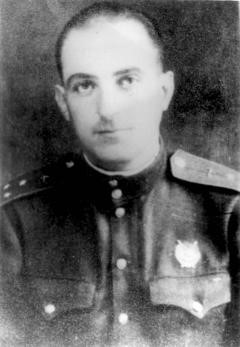
David Genkin
David Genkin was born in 1914 in Gomel, Belorussia. After the Bolshevik Revolution, his mother became a Soviet official (who worked in the field of education). After she died of typhus in 1920, David was brought up by distant relatives. In 1928, he entered a vocational school, and, after graduation, he worked as a worker at the plant. Simultaneously, he participated in the Gomel aviation club. In 1936 or 1934, according to other sources, Davidwas mobilized into the Soviet air force and sent to the Orenburg Military Pilots School, from which he graduated as a lieutenant.
David Genkin took part in the war between the Soviet Union and Germany from July 1941 as the commander of a bombing squad. In the summer of 1941 he fought on the Western Front (in Belorussia and western Russia), with the 30th Airforce Bombing Regiment. Later, he was transferred to the Stalingrad Front and, in December 1942 promoted to commander of a squadron of the 284th Airforce Bombing Regiment. He took part in the Battle of Stalingrad, and afterward he fought in southeastern Ukraine. Genkin was awarded two Orders of the Red Banner and the medal For the Defense of Stalingrad. The citation for his second order was three typed pages long.
On September 27, 1943, Genkin's aircraft did not return from a combat sortie. His squadron had been sent to bomb a railway junction at the former German agricultural colony of Reichenfeld, south of Zaporozhie (today Zaporizhzhia, Ukraine). There the main gasoline tank of his plane was hit by an enemy shell, and the machine immediately caught fire. Genkin descended with his plane and succeeded in dropping his bombs on the Reichenfeld railway station, after which three members of his crew, all of them with burns, parachuted out of their plane. Genkin hoped that they would land on the Soviet territory, but the wind took them westward, to German held territory. One of the crew members the non-Jew Georgii Raitskii was killed while being pursued by the enemies, the others, the chief of the squadron's communication's Nikolai Minchenkov , a non-Jew, and David Genkin were captured by the Germans. Upon noting Genkin's undoubtedly "Semitic" appearance, the Germans began to shout: "Jude! Jude!" The German officer who interrogated the captives asked Genkin whether he was Jewish. Instead of answering, Genkin spat in the face of the interrogator. The Germans poured gasoline on both of their captives and set Genkin and Minchenkov on fire.1
After the war, the members of the Genkin's crew were reburied in a common grave in the village of Plodorodnoe (former Raikhenfeld).
- 1. After the liberation of the vicinity, the regiment commander sent a commission headed by the captain Isaak Vigdorov to ascertain the circumstance of the death of Genkin's crew. Vigdorov's commission interviewed witnesses, and people who wrote about this echoed the commission's conclusions. Here we present the version by Jonas Vainauskas as the most plausible one. A slightly simplified version can be found in the book of memoirs of Nikolai Bondarenko (who was Genkin's comrade in arms), Letim na razvedku, Moscow: Voienizdat, 1976.






